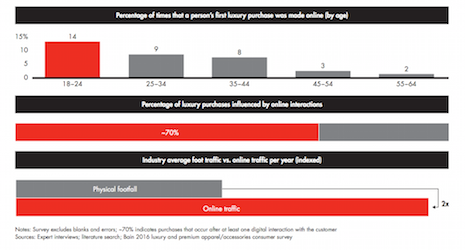 Millennial is a mindset. Photo courtesy of Farfetch
Millennial is a mindset. Photo courtesy of Farfetch
While luxury buyers are primarily older, millennials will soon make up 40 percent of all luxury purchases, according to research from Bain & Company and online retailer Farfetch.
Additionally, older consumers are tending to adopt the shopping trends of younger consumers. This means that luxury brands will have to pay even more attention to the ways that millennials shop for luxury goods.
State of mind
Much research has been done on the ways that millennials shop, noting things like the need for immediacy and relevancy in advertising and retail environments.
But as millennials get older, the types of things they buy change while their behavior remains the same. Older consumers make up the majority of luxury purchasing and as millennials get older and their careers progress, more of them are becoming luxury customers.
This means it is important for luxury brands to look into how millennials shop. And as millennial shopping habits become more defined, they tend to affect the way older consumers shop as well.
Because of this, retailers now need to understand what Bain calls the “millennial state of mind,” a set of shopping habits defined by immediacy and relevance.
 Millennial is not just an age group
The report notes three aspects of the millennial state of mind: uneasiness, urgency and uniqueness.
Uneasiness means that millennial shopper is more likely to be a social shopper. Millennials tend to share their desired items and converse with their friends on social media to determine whether they should buy something or not.
Urgency means that millennial consumers take far less time than older consumers between encountering a product and deciding to buy it. This means a narrower window for retailers to influence purchasing decisions.
Finally, uniqueness means that millennials expect brands to offer personalized and relevant advertising and products to inspire them. They want things that align with their values and desires.
One of the major ways millennials’ shopping habits are unique is their emphasis on digital. Seventy percent of luxury purchases are influenced by digital interactions first.
But physical retail is not dead. In fact, 75 percent of luxury purchases will still occur in a physical store by 2025.
Millennial shopping
This data is especially important for luxury brands as they try to keep their image and branding current to keep up with changing youth trends. Some have more difficulty with this than others.
According to a new study from Hitwise, brands such as Michael Kors and Ralph Lauren are having trouble identifying with younger consumers, aged 18 to 24, but are not showing concern in this area. However, Gucci is significantly above the pack in attracting millennial consumers, which can poise the brand for long-term success (see story).
Millennial is not just an age group
The report notes three aspects of the millennial state of mind: uneasiness, urgency and uniqueness.
Uneasiness means that millennial shopper is more likely to be a social shopper. Millennials tend to share their desired items and converse with their friends on social media to determine whether they should buy something or not.
Urgency means that millennial consumers take far less time than older consumers between encountering a product and deciding to buy it. This means a narrower window for retailers to influence purchasing decisions.
Finally, uniqueness means that millennials expect brands to offer personalized and relevant advertising and products to inspire them. They want things that align with their values and desires.
One of the major ways millennials’ shopping habits are unique is their emphasis on digital. Seventy percent of luxury purchases are influenced by digital interactions first.
But physical retail is not dead. In fact, 75 percent of luxury purchases will still occur in a physical store by 2025.
Millennial shopping
This data is especially important for luxury brands as they try to keep their image and branding current to keep up with changing youth trends. Some have more difficulty with this than others.
According to a new study from Hitwise, brands such as Michael Kors and Ralph Lauren are having trouble identifying with younger consumers, aged 18 to 24, but are not showing concern in this area. However, Gucci is significantly above the pack in attracting millennial consumers, which can poise the brand for long-term success (see story).
 Digital plays a huge part in millennial shopping
Digital will also have to be a major priority for targeting millennials, especially on the mobile channel.
Millennials are increasingly turning to mobile to enhance their in-store experience, with 96 percent of millennials making purchases at stores at which they used their mobile devices to shop (see story).
As millennials age and accrue more wealth and spending power, luxury brands will have to keep a close eye on how this new generation of luxury buyers transforms the industry.
Digital plays a huge part in millennial shopping
Digital will also have to be a major priority for targeting millennials, especially on the mobile channel.
Millennials are increasingly turning to mobile to enhance their in-store experience, with 96 percent of millennials making purchases at stores at which they used their mobile devices to shop (see story).
As millennials age and accrue more wealth and spending power, luxury brands will have to keep a close eye on how this new generation of luxury buyers transforms the industry.
